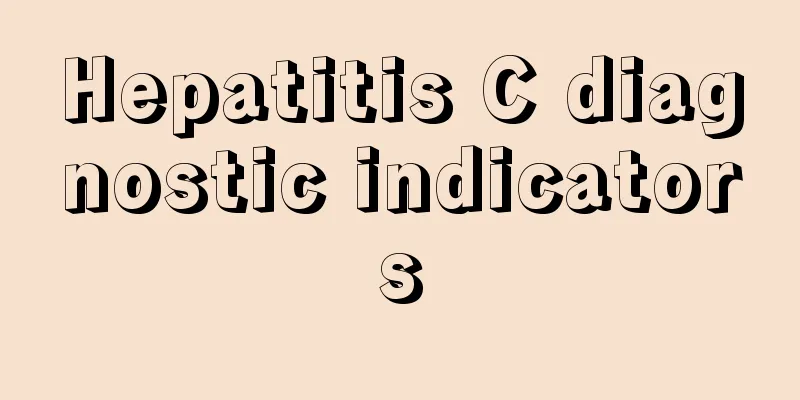Hepatitis C diagnostic indicators

|
Hepatitis C virus belongs to the genus Flavivirus, a single-stranded positive-sense RNA virus with a total length of 9500bp, encoding structural proteins and core proteins. The markers for diagnosing HCV infection are positive HCV-RNA, anti-HCV IgM and anti-HCV IgC. The appearance of antibodies against the former can be used for early diagnosis, usually appearing 2 to 4 days after onset and reaching a peak in half a month. Positive antibodies against the latter indicate that infection has occurred, but are not an early indicator. 1. Acute hepatitis C Acute hepatitis C in adults is relatively mild. Most cases are acute non-icteric hepatitis with elevated ALT levels, while a few are acute icteric hepatitis with mild or moderate jaundice. Symptoms such as nausea, loss of appetite, general weakness, yellow urine and yellow eyes may occur. HCV infection alone rarely causes liver failure. Under natural conditions, only 15% of patients can spontaneously clear HCV and achieve recovery. Without antiviral treatment intervention, 85% of patients will develop chronic hepatitis C. After children are acutely infected with hepatitis C virus, 50% can spontaneously clear HCV. 2. Chronic hepatitis C The symptoms are mild and manifest as common symptoms of hepatitis, such as fatigue, poor appetite, abdominal distension, etc. There may also be no subjective symptoms. The ALT test results fluctuated repeatedly and HCVRNA remained positive. One-third of chronic HCV-infected patients have normal liver function, with persistent positivity for anti-HCV and HCV RNA. Liver biopsy may reveal signs of chronic hepatitis and even cirrhosis. 3. Cirrhosis After 20 to 30 years of HCV infection, 10% to 20% of patients may develop cirrhosis, and 1% to 5% of patients will develop hepatocellular carcinoma (HCC) and die. Once cirrhosis decompensates, such as jaundice, peritoneal effusion, varicose vein bleeding, hepatic encephalopathy, etc., the survival rate drops sharply. 2. HCV-RNA That is, the RNA of the hepatitis C virus, which is the genetic material of HCV and a direct indicator of HCV infection in the body. Currently, the PCR method can be used to directly detect HCV-RNA in the blood and can be used for early diagnosis of HCV infection. Because it appears earlier than hepatitis C antibodies, it is a useful indicator for the etiological diagnosis of hepatitis C and for determining its infectiousness. In short, for patients suspected of hepatitis C who have typical clinical manifestations and whose onset is closely related to blood transfusion and blood products, and who have ruled out other hepatitis, further tests for HCV-RNA and anti-HCV can be conducted. If both HCV-RNA and anti-HCV are positive or HCV-RNA alone is positive, hepatitis C can be confirmed. |
<<: Can I smoke if I have Hepatitis C
>>: There are several types of hepatitis C
Recommend
Can pregnant women with kidney cancer undergo surgery?
The traditional surgical method for treating kidn...
Can I drink hot water from a cup made of as material?
Now more and more people are beginning to pay att...
Adjuvant chemotherapy and neoadjuvant chemotherapy for bladder cancer
Adjuvant chemotherapy is chemotherapy after surge...
There are two obvious black marks on my chin. What's going on?
The chin is not a prone area for problems, as acn...
How to get rid of red bloodshot eyes
Many people must have had their eyes filled with ...
What are some tips for pregnancy testing?
If women feel that they might be pregnant, they m...
How to remove stains on slippers
Slippers are a must-have item in everyone's l...
To prevent gastric cancer, you should develop good living habits
Developing good living habits is very important f...
What are the exercises that can improve kidney function
People should not only pay attention to self-cult...
Specific drugs for treating brain cancer
Brain cancer is a common malignant tumor. There a...
Facial cleanser that is effective in improving acne
Acne is commonly known as acne, which mostly occu...
The harm of baby taking a nap for too long
Napping is a very good habit and is very good for...
Skin allergy is very serious
Human skin is actually a very sensitive and fragi...
Are chestnuts considered nuts?
Chestnuts are a small snack that we often eat, es...
Is it effective to boil Chinese medicine into paste
Nowadays, people pay more attention to health pre...









